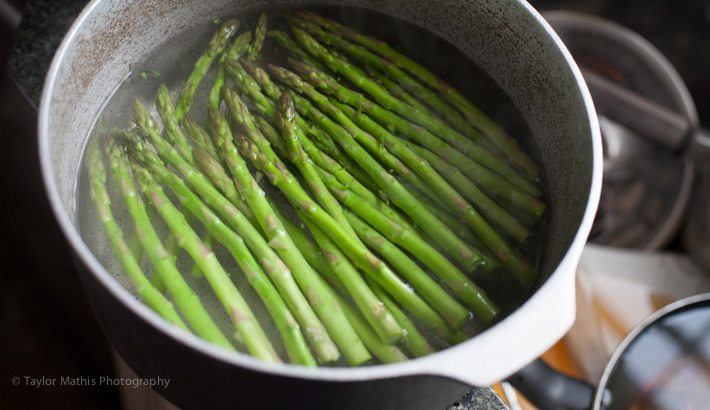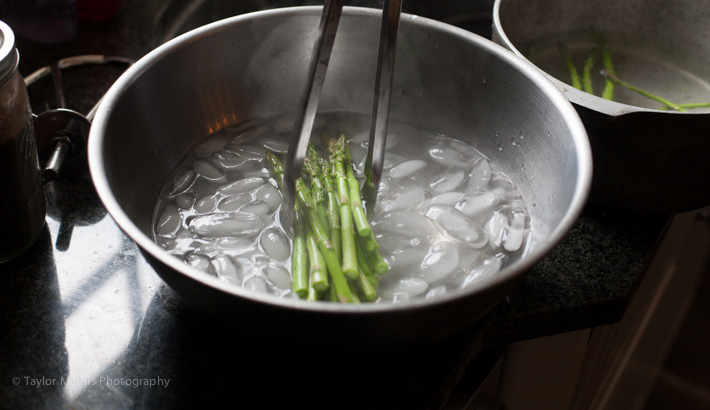Broiling, braising, blanching, roasting, smoking, sautéing, and frying are just a few of the cooking methods that can be done to food. Do you know how they will visually change the appearance of your food? Did you know that some parsley has curly leaves, while other varieties have flat leaves? Would you be able to tell the difference between a julienne, brunoise, or a dice? The culinary world has a vocabulary all its own. Knowing these terms and how they effect the look of food is a necessary skill for every food photographer.

Above is an example of asparagus that is raw and blanched. To get the bright vibrant green that your client may want for their asparagus, you will need to blanch it. Blanching vegetables is very easy.

Cook the asparagus in water that is just at boiling temperature for 2-5 minutes until it starts to develop the bright green color that you desire. When it reaches the color you desire, you will need to stop the cooking process.

You may be thinking to yourself, "I am a photographer. I have a chef who will be cooking all of the food and stylists to take care of all the food so I don't need to know any culinary terms" What if the stylist asks you how large you want the vegetables for the pot pie cut and you say chopped, but what you really mean is a dice? This miscommunication will result in a pie that is visually different than what you had envisioned. In order to ensure that you and the stylists are on the same page, it is important to have a culinary vocabulary.
Here is another scenario. Pretend you are shooting a cuisine that you don't usually eat. For me, that would be Indian or Ethiopian. If an editor wanted me to shoot Poha or Kitfo I would have no idea what color or shape the dish would be. Depending on where you live, cuisines will vary greatly. If you shoot food, there is a chance that you will be assigned to shoot a cuisine that is foreign to you.
In order to get the best shot of the dish you would want to research these dishes ahead of time so you would know what lighting gear and lenses you may need. If there are dishes that have a color, texture, or presentation that they are known for, you would want to make sure your images highlight these characteristics. Expanding your vocabulary and understanding these foreign foods will help ensure that you get the shots your client wants!

Where can you develop your food vocabulary?
If you find yourself getting into food photography, but you aren't familiar with the culinary terms that you may encounter, there are many resources available to you.
- Go to your local library or book store and look at the general cookbooks or cookbooks about a certain cuisine that you will be shooting.
- You can also make friends with a chef and consult them about the process and terms used in making certain foods.
- You can watch the Food Network or Cooking Channel. By watching chefs in action, you can pick up on the terminology they use and the visual changes these terms will have on the dish.
- Take a trip to your local farmer's market and talk with the farmers. They can tell you about the different varieties of their produce and what physical characteristics these different varieties have.
If you are getting started in food photography, learning about food will not only make your pictures more accurate, but it will help inspire your creativity in how you shoot your food! Enjoy the process!
Want to learn more about food photography? Check out issues 1-6 of photographing FOOD.







If I come to North Carolina, you're cooking me dinner, right Taylor?
Great post, by the way
I thought I'd add in another way to change the colour of a certain food. If you want a really vibrant salad onion (the red one) squirt some lemon juice on it. The citric acid reacts with the onion and generally just makes the onion look better
Also works for foods that "rust" like: avocado, apple, raw potatoes.